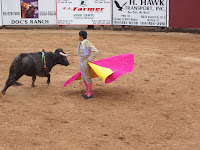My first guess would be that we have bad teeth. Men in green hospital scrubs stand in dental clinic doorways offering teeth cleaning, filings, bridges, crowns, and whitening for 25% of the cost that I have paid my family dentist.
I think we also leave the impression that Americans require an abundance of prescription drugs. I am not sure if this is an exaggeration or not, but the owner of a Progresso cantina told us that there are 400 pharmacies in the city catering to our demand for inexpensive drugs. Ed asked a pharmacist in one drug store, “What’s in big demand?” His response was: Viagra for erectile dysfunction and antibiotics, neither of which requires a prescription in Mexico.
They probably think Americans disregard copyright laws. I found movies still in theaters like “Bucket List” and “Charlie Wilson’s War” available on DVD from street vendors. Prices in Progresso for these DVDs were for $5 each, no negotiation.
They also must think we will buy anything for our grandchildren. We saw women hand-crochet toddler-sized hula skirts and matching pink tops to replace the ones they sold to Grandparents earlier in the day. We saw hoods like wrestlers wear for children wanting to imagine themselves in the ring. Bobble head toy ponies and puppies nodded up and down in motion as vendors offered them to American shoppers. And, there were bracelets for any name imaginable – Brianna, Jason, Suzie, Chris. Just buy them and knot them around the child’s wrist. How about “no.”
Americans shop for ourselves too. Jewelry and pottery seem to dominate the stores and vendor tables. A colorful ladybug caught my eye and now is a delightful paperweight on my clutter of papers in the coach. I bought a collapsible wooden table too just like the one I’d bought in Progresso seven years ago and gave to my Mom. That one fit in a carry-on roller bag in 2001; this one bought for me stores nicely beside my co-pilot seat in the Prevost. It will be the perfect size to set my margarita in its blue swirled drink glass that I also bought or to serve a shot of tequila in the Mexico souvenir shot glass, another purchase.

What must these people think of us?
Progresso, Mexico
January 26, 2008
























































